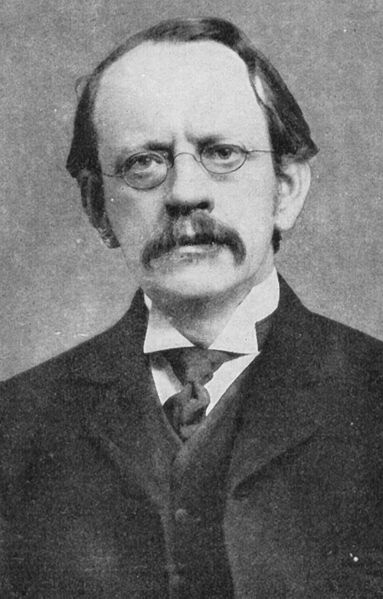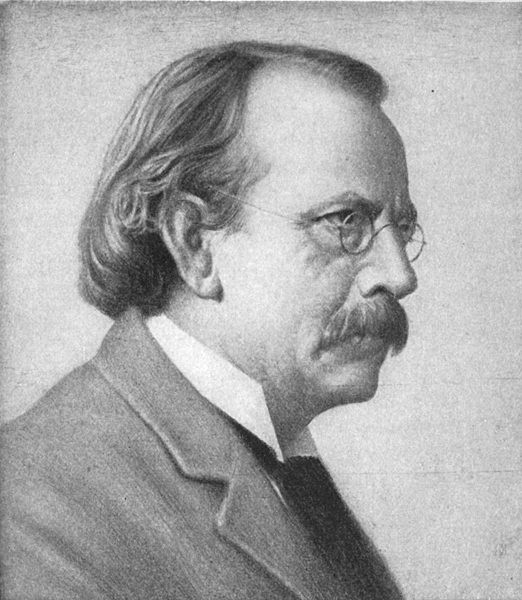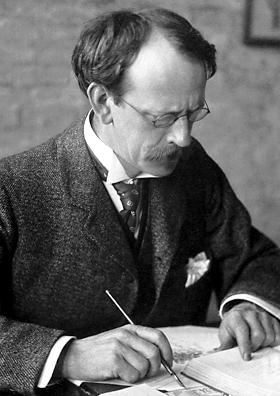<Back to Index>
- Physicist Joseph John "J.J." Thomson, 1856
PAGE SPONSOR



Sir Joseph John "J. J." Thomson, OM, FRS (18 December 1856 – 30 August 1940) was a British physicist and Nobel laureate. He is credited with discovering electrons and isotopes and inventing the mass spectrometer. Thomson was awarded the 1906 Nobel Prize in Physics for the discovery of the electron and for his work on the conduction of electricity in gases.
Joseph John Thomson was born in 1856 in Cheetham Hill, Manchester, England. His mother, Emma Swindells, came from a local textile family. His father, Joseph James Thomson, ran an antiquarian bookshop founded by a great - grandfather from Scotland (hence the Scottish spelling of his surname). He had a brother two years younger than he, Frederick Vernon Thomson.
His early education took place in small private schools where he demonstrated great talent and interest in science. In 1870 he was admitted to Owens College. Being only 14 years old at the time, he was unusually young. His parents planned to enroll him as an apprentice engineer to Sharp - Stewart & Co., a locomotive manufacturer, but these plans were cut short when his father died in 1873. He moved on to Trinity College, Cambridge, in 1876. In 1880, he obtained his BA in mathematics (Second Wrangler and 2nd Smith's prize) and MA (with Adams Prize) in 1883. In 1884 he became Cavendish Professor of Physics. One of his students was Ernest Rutherford, who would later succeed him in the post. In 1890 he married Rose Elisabeth Paget, daughter of Sir George Edward Paget, KCB, a physician and then Regius Professor of Physic at Cambridge. He had one son, George Paget Thomson, and one daughter, Joan Paget Thomson, with her. One of Thomson's greatest contributions to modern science was in his role as a highly gifted teacher, as seven of his research assistants and his aforementioned son won Nobel Prizes in physics. His son won the Nobel Prize in 1937 for proving the wavelike properties of electrons.
He was awarded a Nobel Prize in 1906, "in recognition of the great merits of his theoretical and experimental investigations on the conduction of electricity by gases." He was knighted in 1908 and appointed to the Order of Merit in 1912. In 1914 he gave the Romanes Lecture in Oxford on "The atomic theory". In 1918 he became Master of Trinity College, Cambridge, where he remained until his death. He died on August 30, 1940 and was buried in Westminster Abbey, close to Sir Isaac Newton.
Thomson was elected a Fellow of the Royal Society on 12 June 1884 and was subsequently President of the Royal Society from 1915 to 1920.
Several scientists, such as William Prout and Norman Lockyer, had suggested that atoms were built up from a more fundamental unit, but they envisaged this unit to be the size of the smallest atom, hydrogen. Thomson, in 1897, was the first to suggest that the fundamental unit was over 1000 times smaller than an atom, suggesting the sub - atomic particles now known as electrons. Thomson discovered this through his explorations on the properties of cathode rays. Thomson made his suggestion on 30 April 1897 following his discovery that Lenard rays could travel much further through air than expected for an atomic - sized particle. He estimated the mass of cathode rays by measuring the heat generated when the rays hit a thermal junction and comparing this with the magnetic deflection of the rays. His experiments suggested not only that cathode rays were over 1000 times lighter than the hydrogen atom, but also that their mass was the same whatever type of atom they came from. He concluded that the rays were composed of very light, negatively charged particles which were a universal building block of atoms. He called the particles "corpuscles", but later scientists preferred the name electron which had been suggested by George Johnstone Stoney in 1894, prior to Thomson's actual discovery.
In April 1897 Thomson had only early indications that the cathode rays could be deflected electrically (previous investigators such as Heinrich Hertz had thought they could not be). A month after Thomson's announcement of the corpuscle he found that he could deflect the rays reliably by electric fields if he evacuated the discharge tubes to very low pressures. By comparing the deflection of a beam of cathode rays by electric and magnetic fields he was then able to get more robust measurements of the mass to charge ratio that confirmed his previous estimates. This became the classic means of measuring the charge and mass of the electron.
Thomson believed that the corpuscles emerged from the atoms of the trace gas inside his cathode ray tubes.
He thus concluded that atoms were divisible, and that the corpuscles
were their building blocks. To explain the overall neutral charge of the
atom, he proposed that the corpuscles were distributed in a uniform sea
of positive charge; this was the "plum pudding" model — the electrons
were embedded in the positive charge like plums in a plum pudding
(although in Thomson's model they were not stationary, but orbiting
rapidly).
In 1912, as part of his exploration into the composition of canal rays, Thomson and his research assistant F. W. Aston channeled a stream of ionized neon through a magnetic and an electric field and measured its deflection by placing a photographic plate in its path. They observed two patches of light on the photographic plate, which suggested two different parabolas of deflection, and concluded that neon is composed of atoms of two different atomic masses (neon-20 and neon-22), that is to say of two isotopes. This was the first evidence for isotopes of a stable element; Frederick Soddy had previously proposed the existence of isotopes to explain the decay of certain radioactive elements.
JJ Thomson's separation of neon isotopes by their mass was the first example of mass spectrometry, which was subsequently improved and developed into a general method by F. W. Aston and by A. J. Dempster.
In 1905 Thomson discovered the natural radioactivity of potassium.
In 1906 Thomson demonstrated that hydrogen had only a single electron per atom. Previous theories allowed various numbers of electrons.
Earlier, physicists debated whether cathode rays were immaterial like light ("some process in the aether") or had mass and were composed of particles. The aetherial hypothesis was vague, but the particle hypothesis was definite enough for Thomson to test.
Thomson first investigated the magnetic deflection of cathode rays.
Cathode rays were produced in the side tube on the left of the apparatus
and passed through the anode into the main bell jar, where they were
deflected by a magnet. Thomson detected their path by the fluorescence
on a squared screen in the jar. He found that whatever the material of
the anode and the gas in the jar, the deflection of the rays was the
same, suggesting that the rays were of the same form whatever their
origin.
While supporters of the aetherial theory accepted the possibility that negatively charged particles are produced in Crookes tubes, they believed that they are a mere byproduct and that the cathode rays themselves are immaterial. Thomson set out to investigate whether or not he could actually separate the charge from the rays.
Thomson constructed a Crookes tube
with an electrometer set to one side, out of the direct path of the
cathode rays. Thomson could trace the path of the ray by observing the
phosphorescent patch it created where it hit the surface of the tube.
Thomson observed that the electrometer registered a charge only when he
deflected the cathode ray to it with a magnet. He concluded that the
negative charge and the rays were one and the same.
In May – June 1897 Thomson investigated whether or not the rays could be deflected by an electric field. Previous experimenters had failed to observe this, but Thomson believed their experiments were flawed because their tubes contained too much gas.
Thomson constructed a Crookes tube with a near perfect vacuum. At the start of the tube was the cathode from which the rays projected. The rays were sharpened to a beam by two metal slits – the first of these slits doubled as the anode, the second was connected to the earth. The beam then passed between two parallel aluminum plates, which produced an electric field between them when they were connected to a battery. The end of the tube was a large sphere where the beam would impact on the glass, created a glowing patch. Thomson pasted a scale to the surface of this sphere to measure the deflection of the beam.
When the upper plate was connected to the negative pole of the
battery and the lower plate to the positive pole, the glowing patch
moved downwards, and when the polarity was reversed, the patch moved
upwards.
In his classic experiment, Thomson measured the mass - to - charge ratio of the cathode rays by measuring how much they were deflected by a magnetic field and comparing this with the electric deflection. He used the same apparatus as in his previous experiment, but placed the discharge tube between the poles of a large electromagnet. He found that the mass to charge ratio was over a thousand times lower than that of a hydrogen ion (H+), suggesting either that the particles were very light and/or very highly charged.
The details of the calculation are:
The electric deflection is given by Θ = Fel/mv2 where Θ is the angular electric deflection, F is applied electric intensity, e is the charge of the cathode ray particles, l is the length of the electric plates, m is the mass of the cathode ray particles and v is the velocity of the cathode ray particles.
The magnetic deflection is given by φ = Hel/mv where φ is the angular magnetic deflection and H is the applied magnetic field intensity.
The magnetic field was varied until the magnetic and electric deflections were the same, when Θ = φ and Fel/mv2= Hel/mv. This can be simplified to give m/e = H2l/FΘ. The electric deflection was measured separately to give Θ and H, F and l were known, so m/e could be calculated.
As the cathode rays carry a charge of negative electricity, are deflected by an electrostatic force as if they were negatively electrified, and are acted on by a magnetic force in just the way in which this force would act on a negatively electrified body moving along the path of these rays, I can see no escape from the conclusion that they are charges of negative electricity carried by particles of matter.—J. J. Thomson
As to the source of these particles, Thomson believed they emerged from the molecules of gas in the vicinity of the cathode.
If, in the very intense electric field in the neighbourhood of the cathode, the molecules of the gas are dissociated and are split up, not into the ordinary chemical atoms, but into these primordial atoms, which we shall for brevity call corpuscles; and if these corpuscles are charged with electricity and projected from the cathode by the electric field, they would behave exactly like the cathode rays.—J. J. Thomson
Thomson imagined the atom as being made up of these corpuscles orbiting in a sea of positive charge; this was his plum pudding model. This model was later proved incorrect when Ernest Rutherford showed that the positive charge is concentrated in the nucleus of the atom.
- Royal Medal (1894)
- Hughes Medal (1902)
- Nobel Prize for Physics (1906)
- Elliott Cresson Medal (1910)
- Copley Medal (1914)
- Franklin Medal (1922)
In 1991 the thomson (symbol: Th) was proposed as a unit to measure mass - to - charge ratio in mass spectrometry.